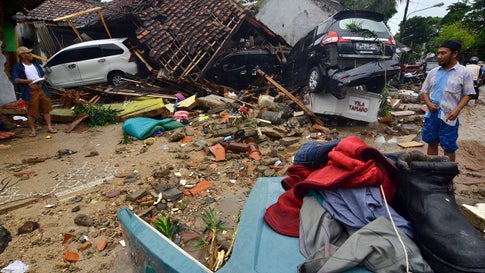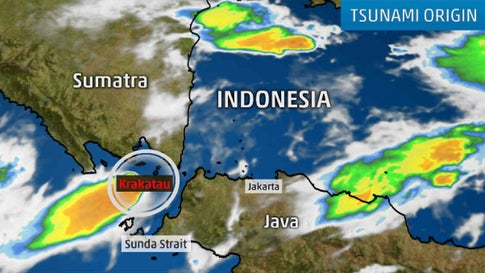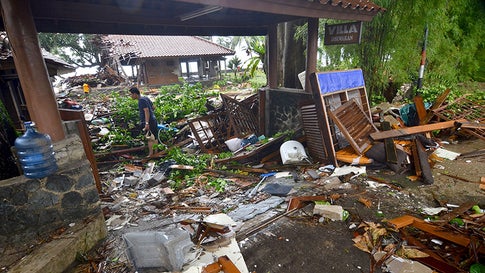
AT LEAST 222 KILLED AND MORE THAN 800 WOUNDED AFTER TSUNAMI STRIKES INDOSESIA WHILE ARAK KRAKATAU VOLCAHNO ERUPTS
AP
At a Glance
- At least 373 are dead and over 1,400 are missing after a tsunami struck the western edge of Indonesia's Java Island late Saturday.
- The tsunami may have been caused by an underwater landslide.
- An eruption of the Anak Krakatau volcano may have triggered the landslide.
At least 373 people are confirmed dead and more than 1,400 were injured in Indonesia following the country’s latest tsunami, as scientists collected evidence on how a volcanic eruption triggered the weekend tragedy.
The death toll from Saturday night’s disaster was certain to rise further, with 128 people still missing from the affected areas along the coastlines of western Java and southern Sumatra islands where many people were celebrating the Christmas holiday weekend. Now, hundreds of military personnel and volunteers are conducting their grim search along debris-strewn beaches.
The tsunami, which hit at 9:27 p.m. Saturday, may have been a result of an undersea landslide near the Anak Krakatau Volcano. Anak Krakatau, which means "Child of Krakatau," was erupting again on Sunday, spewing ash and smoke.
Scientists, including those from Indonesia's Meteorology and Geophysics agency, said the tsunami could have been caused by undersea landslides or those occurring above sea level on the volcano's steep outside slope following the eruption of Anak Krakatau, which means "Child of Krakatau." The volcano has seen increased activity in recent months with people asked to avoid the area around its crater.
On Friday it erupted for two minutes and 12 seconds, creating an ash cloud that rose more than 1,000 feet above the mountain. It erupted again about 24 minutes before the tsunami, the geophysics agency said.
David Applegate, associate director for natural hazards at the U.S. Geological Survey, told the Washington Post the tsunami wasn't caused by an earthquake, as 90 percent of tsunamis are. Because it may have been triggered by volcanic activity that led to a submarine landslide, there was no warning.
“This is probably the ultimate no-notice event,” Applegate told the newspaper.
The worst-affected area was the Pandeglang region of Java's Banten province, which encompasses Ujung Kulon National Park and popular beaches, Indonesia's disaster agency said.
Dramatic footage posted on social media showed the Indonesian pop band Seventeen performing under a tent on a popular beach at a concert for employees of the state-owned electricity company. Dozens of people sat listening at tables covered in white cloths while others bobbed to the music near the stage as bright strobe lights flashed.
A child could also be seen wandering through the crowd. Seconds later, with the drummer pounding just as the next song was about to begin, the stage suddenly heaved forward and buckled from the force of the water, throwing the band and all their equipment into the audience.
One crew member, identified by Channel News Asia only by the first name Zack, said he survived by holding on to part of the collapsed stage.
“Underwater, I could only pray ‘Jesus Christ, help!’,” Zack said of his struggle in the water. “In the final seconds, I almost ran out of breath.”
Seventeen’s bass player, guitarist, drummer, road manager and technician were all killed. The lead singer, Riefian Fajarsyah, survived, but his wife, who was also a backup singer, remains missing.
"The tide rose to the surface and dragged all the people on site," the statement said. "Unfortunately, when the current receded our members are unable to save themselves while some did not find a place to hold on."
Tourists were also affected during the long holiday weekend ahead of Christmas.
"I had to run, as the wave passed the beach and landed 15-20m (meters, or 50-65 feet) inland," Norwegian Oystein Lund Andersen wrote on Facebook. The self-described photographer and volcano enthusiast said he was taking pictures of the volcano when he suddenly saw a big wave come toward him.
"Next wave entered the hotel area where I was staying and downed cars on the road behind it," he wrote. "Managed to evacuate with my family to higher ground (through) forest paths and villages, where we are taken care of (by) the locals. Were unharmed, thankfully."

Azki Kurniawan, 16, said his first warning about the tsunami was when people burst into the lobby of the Patra Comfort Hotel shouting, "Sea water rising!"
Kurniawan, who was undergoing vocational training with a group of 30 other students, said he was confused because he had not felt a big earthquake. He said he ran to the parking lot to try to reach his motorbike but discovered it was already flooded.
"Suddenly, a 1-meter (3.3-foot) wave hit me," he said, his eyes red and swollen from crying. "I was thrown into the fence of a building about 30 meters (100 feet) from the beach and held onto the fence as strong as I could, trying to resist the water, which felt like it would drag me back into the sea. I cried in fear ... 'This is a tsunami?' I was afraid I would die."
Indonesia's disaster agency said 222 deaths had been confirmed and at least 843 people were injured. Rescue workers were still trying to access other affected areas.
Indonesian President Joko "Jokowi" Widodo expressed his sympathy and ordered government agencies to respond quickly to the disaster.
"My deep condolences to the victims in Banten and Lumpung provinces," he said. "Hopefully, those who are left have patience."
In the city of Bandar Lampung on Sumatra island, hundreds of residents took refuge at the governor's office.
Alif, a resident of Pandeglang district who goes by one name, told MetroTV station that many people were still searching for missing relatives.
The Anak Krakatau volcano lies in the Sunda Strait between Java and Sumatra islands, linking the Indian Ocean and Java Sea. The 1,000-foot-high volcano, about 124 miles southwest of Jakarta, the capital, has been erupting since June. In July, authorities widened its no-go areas to 1.2 miles from the crater.

However, Anak Krakatau remains much smaller than Krakatoa when it blew in 1883, killing more than 30,000 people. Krakatoa launched far-reaching tsunamis and created so much ash, day was turned to night in the area and a global temperature drop was recorded. The violent explosions sank most of the island into the volcanic crater under the sea, and the area remained calm until the 1920s, when Anak Krakatau began to rise from the site. It continues to grow each year and periodically erupts.
Gegar Prasetya, co-founder of the Tsunami Research Center Indonesia, said Saturday's tsunami was likely caused by a flank collapse — when a big section of a volcano's slope gives way. He said it's possible for an eruption to trigger a landslide above ground or beneath the ocean, both capable of producing waves.
"Actually, the tsunami was not really big, only 1 meter (3.3 feet)," said Prasetya, who has closely studied Krakatoa. "The problem is people always tend to build everything close to the shoreline."
Nine hotels, 430 homes and 10 vessels were heavily damaged. Footage posted by the head of the disaster agency showed the aftermath of flooded streets and an overturned car.
In September, more than 2,500 people were killed by a quake and tsunami that hit the city of Palu on the island of Sulawesi, which is just east of Borneo.
Saturday's tsunami triggered memories for some of the massive magnitude 9.1 earthquake that hit on Dec. 26, 2004. It spawned a giant tsunami off Sumatra island in western Indonesia, killing more than 230,000 people in a dozen countries — the majority in Indonesia. The vast archipelago of more than 17,000 islands is home to 260 million people and lies along the "Ring of Fire," an arc of volcanoes and fault lines in the Pacific Basin.
Roads and infrastructure are poor in many areas of disaster-prone Indonesia, making access difficult in the best of conditions.

